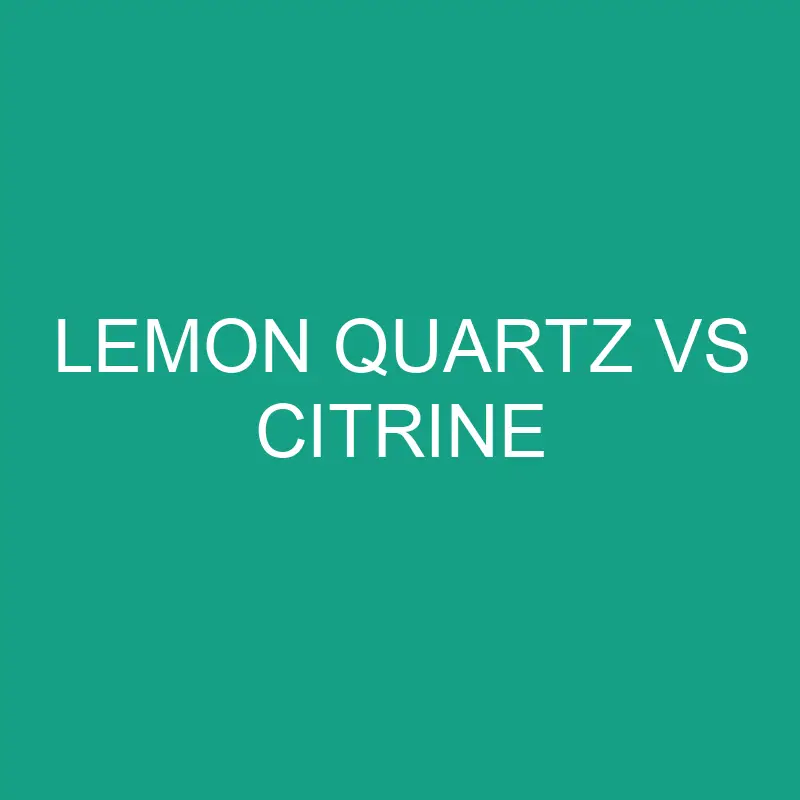Unveiling the Radiant World of Yellow Gemstones
Gemstones, with their myriad hues and metaphysical allure, have captivated human fascination for centuries. In the realm of yellow gemstones, two radiant options stand out: Lemon Quartz and Citrine. In this comparative exploration, we will dive into the distinctive features, geological origins, and metaphysical properties of Lemon Quartz and Citrine, shedding light on these dazzling gems that bring a burst of sunshine to the world of jewelry.
Post Contents
Lemon Quartz: The Citrus Elegance
Origins and Geological Background:
- Composition: Lemon Quartz is a variety of macrocrystalline quartz, primarily composed of silicon dioxide with trace elements.
- Color: True to its name, Lemon Quartz displays a vibrant lemon-yellow hue.
- Formation: Lemon Quartz, like other varieties of quartz, forms in igneous, metamorphic, and sedimentary rocks.
Physical Properties:
- Color and Appearance: Intense lemon-yellow color with a transparent to translucent appearance.
- Transparency: Transparent to translucent.
- Crystal Structure: Lemon Quartz belongs to the hexagonal crystal system.
- Hardness: It boasts a hardness of 7 on the Mohs scale.
Origins and Mining:
- Locations: Lemon Quartz is found in various locations globally, including Brazil, Africa, and the United States.
- Mining: Extracted through traditional mining methods, Lemon Quartz is then cut and faceted to enhance its brilliance.
Metaphysical Properties:
- Energizing and Uplifting: Lemon Quartz is associated with qualities of energy, clarity, and joy.
- Creativity and Focus: It is believed to stimulate creativity and enhance focus.
Uses in Jewelry and Art:
- Jewelry: Lemon Quartz is popular in various jewelry pieces, including rings, necklaces, earrings, and bracelets.
- Faceted and Cabochon Cuts: Its clarity and vibrant color make it suitable for faceted cuts, as well as cabochon styles.
Citrine: The Golden Glow of Abundance
Origins and Geological Background:
- Composition: Citrine is a variety of quartz, sharing a similar composition with Lemon Quartz, primarily composed of silicon dioxide.
- Color: Ranging from pale yellow to deep golden hues, Citrine is often referred to as the “healing quartz.”
- Formation: Like Lemon Quartz, Citrine forms in various geological environments.
Physical Properties:
- Color and Appearance: Yellow to golden hues, sometimes with a slight orange or brownish tint.
- Transparency: Transparent to translucent.
- Crystal Structure: Citrine belongs to the hexagonal crystal system, sharing this characteristic with other quartz varieties.
- Hardness: Citrine has a hardness of 7 on the Mohs scale.
Origins and Mining:
- Locations: Notable sources of Citrine include Brazil, Spain, Russia, France, and the United States.
- Mining: Extracted through traditional mining methods, Citrine is often found alongside other minerals and quartz varieties.
Metaphysical Properties:
- Abundance and Manifestation: Citrine is associated with abundance, prosperity, and manifestation of goals.
- Positive Energy: It is believed to carry the energy of the sun, bringing warmth and positivity.
Uses in Jewelry and Art:
- Jewelry: Citrine is a popular choice for various jewelry pieces, including rings, pendants, earrings, and bracelets.
- Faceted and Cabochon Cuts: Citrine’s versatility allows for faceted cuts to enhance its sparkle, as well as cabochon styles to showcase its warm, golden glow.
Comparative Analysis: Lemon Quartz vs. Citrine
Color and Appearance:
- Lemon Quartz: Intense lemon-yellow color.
- Citrine: Ranges from pale yellow to deep golden hues, sometimes with a slight orange or brownish tint.
Transparency:
- Lemon Quartz: Transparent to translucent.
- Citrine: Transparent to translucent.
Crystal Structure:
- Lemon Quartz: Hexagonal crystal system.
- Citrine: Hexagonal crystal system.
Hardness (Mohs Scale):
- Lemon Quartz: 7.
- Citrine: 7.
Origins and Mining:
- Lemon Quartz: Found globally, including Brazil, Africa, and the United States.
- Citrine: Notable sources include Brazil, Spain, Russia, France, and the United States.
Metaphysical Properties:
- Lemon Quartz: Associated with energy, clarity, and joy; believed to stimulate creativity.
- Citrine: Associated with abundance, prosperity, and positive energy; believed to carry the energy of the sun.
Uses in Jewelry and Art:
- Lemon Quartz: Popular in various jewelry pieces, suitable for faceted cuts and cabochon styles.
- Citrine: A versatile choice for jewelry, favored for both faceted and cabochon cuts.
Conclusion: Choosing Between Lemon Quartz and Citrine
Lemon Quartz and Citrine, with their radiant yellow hues, offer individuals a choice of gemstones that embody the warmth and energy of the sun. Lemon Quartz, with its intense lemon-yellow color, is associated with clarity, energy, and creativity, making it a vibrant choice for those seeking a burst of joy in their jewelry.
On the other hand, Citrine, with its varying shades of golden warmth, is often linked with abundance, prosperity, and positive energy. It is a gem that carries the essence of the sun, providing wearers with a sense of positivity and the manifestation of goals.
The choice between Lemon Quartz and Citrine ultimately depends on individual preferences, both in terms of color intensity and the metaphysical properties one resonates with. Whether adorning yourself with a Lemon Quartz pendant or a Citrine ring, these gemstones bring not only aesthetic beauty but also the potential for positive energies and personal empowerment. Whichever you choose, the radiant world of yellow gemstones invites you to embrace the warmth and vibrancy they offer.
